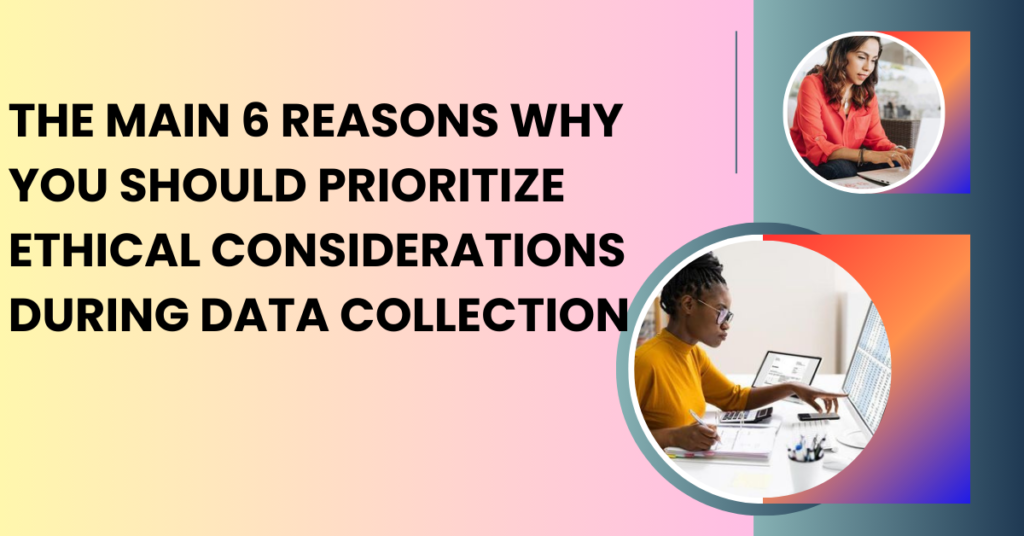
Menu
Facebook-f
Twitter
Google-plus-g
Understanding Data Collection Tools In Research
Data collection is a crucial part of any research study, as it provides the foundation for analysis, interpretation, and conclusions. The choice of data collection tools can significantly impact the quality, reliability, and validity of the data gathered. This guide provides an overview of the key data collection tools you need to know, helping you select the most appropriate methods for your research.
1. Surveys and Questionnaires
Overview:
- Definition: Surveys and questionnaires are structured tools used to collect data from a large number of respondents in a standardized manner. They consist of a series of questions that can be either open-ended or close-ended.
- Purpose: These tools are ideal for gathering quantitative data, such as opinions, behaviors, and demographic information. They are often used in social science, market research, and health studies.
Types:
- Online Surveys: Conducted via digital platforms like Google Forms, SurveyMonkey, or Typeform, these are convenient and cost-effective, allowing for broad reach and easy data analysis.
- Paper-based Surveys: Though less common in the digital age, paper surveys are still used in settings with limited internet access or for specific populations (e.g., older adults).
- Interviews: Structured or semi-structured interviews, often categorized under surveys, allow for deeper exploration of specific topics.
Advantages:
- Scalability: Surveys can reach a large number of respondents quickly.
- Cost-effective: Especially with online tools, surveys can be conducted at a low cost.
- Standardization: Standardized questions ensure consistency in data collection.
Disadvantages:
- Limited Depth: Close-ended questions may not capture the full complexity of respondents’ opinions.
- Response Bias: Respondents may not always provide honest answers, especially on sensitive topics.
When to Use:
- Use surveys and questionnaires when you need to collect data from a large, diverse population and when standardization is important.
2. Interviews
Overview:
- Definition: Interviews are a qualitative data collection method involving direct, face-to-face, telephone, or video communication with respondents. They can be structured, semi-structured, or unstructured.
- Purpose: Interviews are used to gather detailed, in-depth information and insights, particularly when exploring complex behaviors, motivations, or experiences.
Types:
- Structured Interviews: Consist of pre-determined questions with little variation, allowing for easy comparison between respondents.
- Semi-Structured Interviews: Combine a set of standard questions with the flexibility to explore topics that arise during the conversation.
- Unstructured Interviews: These are open-ended conversations without a fixed set of questions, allowing for a natural flow of discussion.
Advantages:
- Depth of Information: Interviews provide rich, detailed data that can reveal the underlying reasons behind behaviors or attitudes.
- Flexibility: Semi-structured and unstructured interviews allow for the exploration of new topics as they arise.
Disadvantages:
- Time-Consuming: Interviews require significant time to conduct and analyze, especially when dealing with large sample sizes.
- Interviewer Bias: The presence and behavior of the interviewer can influence respondents’ answers.
When to Use:
- Use interviews when you need to explore complex issues, gain in-depth insights, or understand individual experiences in detail.
3. Focus Groups
Overview:
- Definition: Focus groups involve guided discussions with a small group of participants, facilitated by a moderator. This qualitative tool is used to explore attitudes, perceptions, and ideas about a particular topic.
- Purpose: Focus groups are ideal for exploring group dynamics, generating ideas, and understanding collective perspectives.
Types:
- Traditional Focus Groups: Conducted in person, usually with 6-12 participants, and moderated to ensure productive discussion.
- Online Focus Groups: Conducted via video conferencing platforms, allowing for participation from geographically dispersed individuals.
Advantages:
- Interactive Discussions: Participants can build on each other’s ideas, leading to richer data.
- Exploration of Group Dynamics: Understanding how opinions form and change within a group setting.
Disadvantages:
- Dominant Voices: Some participants may dominate the discussion, skewing the results.
- Logistical Challenges: Coordinating schedules and ensuring balanced participation can be difficult.
When to Use:
- Use focus groups when you need to explore collective views, generate new ideas, or test concepts with a target audience.
4. Observations
Overview:
- Definition: Observation involves systematically watching and recording behaviors, events, or conditions as they occur in their natural setting. This method can be either structured or unstructured.
- Purpose: Observation is particularly useful for studying behaviors and interactions in real-world settings without influencing the subjects.
Types:
- Participant Observation: The researcher actively engages in the activities while observing, often used in ethnographic studies.
- Non-Participant Observation: The researcher observes without becoming involved in the activities, often used in educational, psychological, or sociological studies.
- Overt vs. Covert Observation: Overt observation means subjects are aware they are being observed, while covert observation is done without their knowledge.
Advantages:
- Real-Time Data: Captures behaviors and events as they happen, providing context-rich data.
- Non-Intrusive: When conducted covertly, observation does not interfere with natural behaviors.
Disadvantages:
- Subjectivity: The researcher’s interpretations can introduce bias into the data.
- Ethical Concerns: Covert observation raises ethical issues, especially regarding consent and privacy.
When to Use:
- Use observation when studying behaviors or interactions in their natural environment is critical to your research.
5. Case Studies
Overview:
- Definition: A case study is an in-depth investigation of a single individual, group, event, or community. It provides detailed, contextualized insights into the subject of study.
- Purpose: Case studies are particularly valuable for exploring new or complex phenomena, generating hypotheses, and providing real-world examples.
Types:
- Intrinsic Case Studies: Focus on understanding a specific case for its own sake.
- Instrumental Case Studies: Use a case to gain insights into a broader issue or theory.
- Collective Case Studies: Involve multiple cases to explore similarities and differences.
Advantages:
- Detailed Insights: Case studies provide a deep understanding of the subject, capturing nuances and context.
- Flexibility: The method allows for the exploration of various aspects of the case, adapting to emerging findings.
Disadvantages:
- Limited Generalizability: Findings from case studies may not be applicable to other contexts or populations.
- Time-Intensive: Conducting a thorough case study requires significant time and resources.
When to Use:
- Use case studies when in-depth analysis and context-specific insights are needed, particularly in exploratory research.
6. Document and Content Analysis
Overview:
- Definition: Document and content analysis involves systematically reviewing and interpreting existing documents, texts, or media to extract relevant information. This method is used in both qualitative and quantitative research.
- Purpose: It is particularly useful for studying historical trends, communication patterns, and cultural representations.
Types:
- Qualitative Content Analysis: Focuses on interpreting themes, meanings, and patterns in the text.
- Quantitative Content Analysis: Involves counting and categorizing specific elements within the text to identify trends or relationships.
Advantages:
- Non-Intrusive: Analyzing existing documents avoids the need for direct interaction with subjects.
- Rich Historical Data: Provides access to information from past events, decisions, or communications.
Disadvantages:
- Limited Availability: The scope of analysis is constrained by the availability and completeness of documents.
- Interpretation Bias: The researcher’s perspective may influence the analysis of qualitative content.
When to Use:
- Use document and content analysis when researching historical events, communication patterns, or cultural phenomena, especially when primary data collection is not feasible.
7. Experimental Tools
Overview:
- Definition: Experimental tools involve manipulating one or more variables to determine their effect on other variables. This method is primarily used in scientific research, including psychology, medicine, and social sciences.
- Purpose: Experiments are designed to establish cause-and-effect relationships between variables.
Types:
- Laboratory Experiments: Conducted in a controlled environment, allowing for precise manipulation of variables.
- Field Experiments: Conducted in a natural setting, offering more ecological validity but less control over variables.
- Quasi-Experiments: Similar to true experiments but lack random assignment to groups, often used when ethical or practical constraints prevent randomization.
Advantages:
- Control Over Variables: Allows researchers to isolate and test the effects of specific variables.
- Replication: Experiments can be replicated to verify results.
Disadvantages:
- Artificiality: Laboratory experiments may lack ecological validity due to their artificial settings.
- Ethical Concerns: Manipulating variables, especially in human subjects, can raise ethical issues.
When to Use:
- Use experimental tools when you need to establish causal relationships between variables and can control the research environment.
8. Mixed Methods
Overview:
- Definition: Mixed methods combine qualitative and quantitative data collection tools in a single study to leverage the strengths of both approaches. This method is increasingly popular in social sciences, education, and health research.
- Purpose: Mixed methods provide a comprehensive understanding of the research problem by integrating diverse data sources.
Types:
- Sequential Mixed Methods: One type of data collection (qualitative or quantitative) follows the other, with each phase informing the next.
- Concurrent Mixed Methods: Both qualitative and quantitative data are collected simultaneously, allowing for a holistic analysis.
Advantages:
- Comprehensive Data: Provides a more complete picture by combining different types of data.
- Flexibility: Adapts to complex research questions that require multiple perspectives.
Disadvantages:
- Complexity: Designing and conducting mixed-methods research can be challenging and time-consuming.
- Resource-Intensive: Requires expertise in both qualitative and quantitative methods.
When to Use:
- Use mixed methods when a single data collection tool cannot fully address your research questions, and you need a more comprehensive approach.
Conclusion
Choosing the right data collection tools is critical to the success of your research. Each tool has its strengths and limitations, and the choice should be guided by your research objectives, the nature of the data needed, and the context of your study. By understanding these tools and their appropriate applications, you can enhance the quality and reliability of your research findings.
Address List
-
Makerere Hill Road, Ham Towers -
+256-703947778 -
info@professionalwriters.shop
Social Networks
Links List
Professional Writers Inc.
Turning Ideas Into Reality
Online Academic Research Writing Training [Free]



















